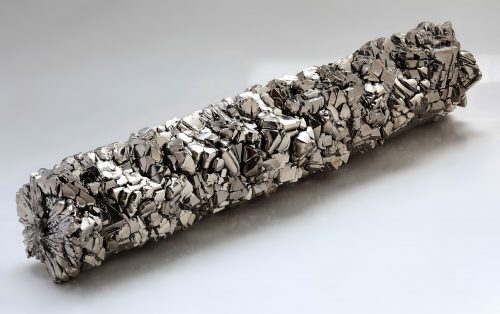When we study the properties of elements in a typical chemistry classroom, we assume the elements are subject to normal atmospheric pressure on Earth. But have you ever wondered what would happen to an atom if you compressed it at three million times standard Earth pressure? Researchers at the Chalmers University of Technology in Sweden developed a quantum mechanical model to study this question, by measuring the effect of uniform compression on ninety-three elements. While our atmosphere only exerts a pressure of around 0.0001 gigapascals (GPa), researchers put these elements under a pressure range of zero to three hundred gigapascals (GPa). Elemental properties are best understood at pressures less than ten GPa. Thus, scientists wanted to understand what happens to elements at higher pressure.
Pressure is the gateway to understanding new chemical structures and bonding patterns. “Weird things can happen under high pressure,” said Professor Martin Rahm, who led the research. “Normally, we as chemists, have this pride in our chemical intuition, that we can predict things based on electronegativity and other chemical properties. I realized under high pressure conditions, predicting these structures is really difficult. It is in part because we don’t have these simple, chemical descriptors, one being electronegativity, at high pressure points.” Finding little work relating compressed atoms to periodic trends, Rahm set out in uncharted territory.
In order to compress individual atoms, the eXtreme Pressure Polarizable Continuum Model (XP-PCM) was employed. This model involves placing an atom in a simulated void with an external medium applying uniform compression— a setup they have termed direct isotropic pressure. Repulsive interactions occur between the atom and the medium; in other words, by decreasing the radius of the cavity, the pressure increases. As the cavity volume decreases, the medium shrinks alongside it, causing an increase in the electron density of the surroundings. A spatial overlap of the electron density of the medium with the electron distribution of the atom develops, causing the inward pressure and repulsion to increase.
Electronegativity is the tendency of an atom to attract electrons towards itself. Many factors determine an atom’s electronegativity, including the number of protons, the number of electrons, and the distance the electrons are from the nucleus. Under high pressure, the space available for protons of one atom to attract the electrons of another atom decreases. Thus, it is expected that an atom’s electronegativity decreases under high pressure. Because electrons are forced to occupy other less-comfortable spaces, the electrons’ kinetic energies increase. Increased kinetic energy results in higher energy electron orbitals—the spaces where electrons exist around an atom. Consequently, electrons have weaker attractions to the nucleus.
In order to assess the chemical property changes of the ninety-three elements under compression, the elements were divided up into categories with similar results. Elements one through eighteen, including many common elements essential for life like hydrogen, oxygen, and carbon, undergo progressive destabilization as the cavity shrinks and pressure rises. This causes the average electron energy to increase, which in turn lowers the electronegativity of these singular atoms. In the second category are transition metals, which completely change the organization of their electrons under pressure. Several atoms are predicted to undergo this dramatic ground-state configuration change under pressure, including titanium, vanadium, manganese, cobalt, nickle, zirconium, and tungsten.
Main group elements 31−36, 49−54, and 81−86 are largely unaffected by compression. These retain their ground-state electronic configurations from one atmospheric pressure up until three hundred GPa. As such, they experience only minor changes in electronegativity. All elements in groups one to ten, with the exception of palladium, the lanthanides series, and the actinides series, are expected to undergo ground-state conformational transitions at pressures of three hundred GPa or lower.
The researchers noted that most of the electron reconfigurations happened between two types of orbitals which differ in shape. It is to be concluded that, at high pressures, the compression causes the competition between the two types of orbitals for electrons to disappear. Consequently, different elements can have the same electron configuration.
Despite these differences, some basic chemical principles are still obeyed under high pressure. The Aufbau principle, for example, states that the lowest energy orbitals fill up before higher energy orbitals. Under higher pressure, the Aufbau principle is not violated. Electron shells are still filled from low energy to high energy. “The Aufbau principle is strengthened under pressure,” Rahm said.
In addition, the rule that every orbital is first occupied by one electron before taking on a second electron is never violated for a single atom. However, the energy ordering rule cannot be a predictive measure for atomic electron configurations under high pressure. Scandium and titanium become the most electropositive elements at three hundred GPa, while neon, helium, and fluorine remain the most electronegative ones.
Considering that ground-state configurations of most atoms and their electronegativities are different at higher pressures, chemistry would look strange at three hundred GPa. Moreover, chemical reactions proceed in a very different fashion. For example, an increased electronegativity difference between Kr and O at high pressure results in the unusual stability of KrO, an otherwise unstable molecule at normal pressure. “This information about changing ground states and increasing electronegativity differences at high compression is essential to our understanding of chemical structural changes at varying pressures,” Rahm said. Given the attention this work has received, many are looking to Rahm’s group for another big breakthrough in our understanding of atomic structure. Rahm, like the atoms he tests, is thriving under the pressure.

